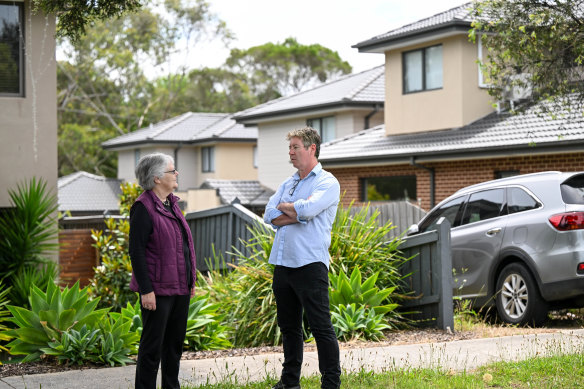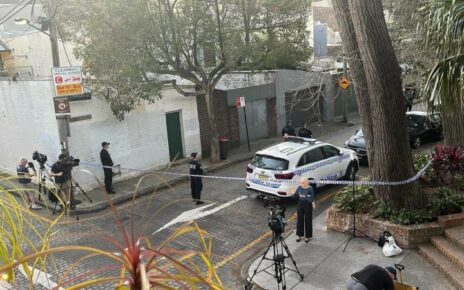Save articles for later
Add articles to your saved list and come back to them any time.
Do you get on well enough with your neighbours to agree to tear down each other’s fences, demolish your homes and team up to build new medium-density housing on your newly merged property?
Homeowners in two neighbourhoods in Melbourne’s outer east have been given that power in a novel change to local planning laws aimed at curbing tree loss caused by widespread housing subdivision.
Swinburne University’s Stephen Glackin and Croydon Conservation Society president Liz Sanzaro in Croydon South, where Maroondah City Council has changed its planning scheme to encourage greater housing density.Credit: Joe Armao
The pilot scheme has been approved by the state government in two pockets of Ringwood and Croydon South. If successful, it could be expanded to other parts of Melbourne.
Maroondah City Council has given landowners in these two low-rise residential precincts the right to amalgamate their properties and build as high as four storeys if they meet certain urban design conditions.
These include preserving space for trees and making room for new walking and cycling paths. The council has estimated that the density push will begin to bear fruit in the next three to five years, as the concept catches on.
It has projected that the number of homes in the precincts will grow about 70 per cent within 15 years. But the urban planning expert who developed the concept has warned that properties in the two precincts were still being subdivided, damaging the scheme’s chance of success.
“The whole aim [of the pilot] is to stop sprawl, to get more houses in but try and keep some of the greenery,” said Dr Stephen Glackin from Swinburne University’s Centre for Urban Transitions. The scheme experienced a near three-year delay in gaining state government approval, finally being gazetted in December last year instead of the target date of January 2020.
“Unfortunately in the four or five years it took to get all these planning amendments through … at least half of these lots have been redeveloped, there’s new development there in the back garden, and those sites are off the market in terms of redevelopment for another 30 years.”
Maroondah is one of Melbourne’s leafiest local government areas, but is losing trees rapidly. It lost more than 3 per cent of its tree canopy cover between 2014 and 2018, research for the Department of Transport and Planning revealed.
The council estimates that when a property in the area is subdivided, as much as 40 per cent of the redeveloped lot is devoted to driveways, leaving no space for new trees.
Maroondah Mayor Kylie Spears said the pilot project – called Greening the Greyfields – targets middle and outer suburban neighbourhoods where homes were ageing, but land values remained high, making them ripe for redevelopment.
The laws encourage greater housing density by allowing taller buildings to be built on larger lots where increased space has been created for greenery, walking and cycling. “Through land amalgamation, precincts can be formed to allow for improved residential development outcomes,” Spears said.
It is the first time the concept has been introduced to a planning scheme in Australia. The Ringwood precinct was chosen because it is within easy walking distance to the suburb’s commercial heart and train station.
Analysis projects the number of homes in the precinct will grow 72 per cent between 2020 and 2035, from 290 to 500 units.
The Croydon South precinct was chosen because it is quintessentially suburban, Glackin said. “Most Australian suburbs are actually really conservative, so we thought, if it works there, it will work everywhere.”
But Spears conceded that, one year after the scheme’s gazettal, no property owners in the two precincts had yet taken the opportunity to amalgamate their housing lots.“There are currently no housing proposals under way with this approach,” she said.
The council is still speaking with property developers, industry representatives and landowners to encourage uptake, Spears said.
Janet Franklin lives in the Ringwood precinct and said she would consider amalgamating her lot with neighbours if there was “a good financial offer”.
“But I can’t see it working too well, because so many of the blocks on this street have already been developed into dual occupancy,” she said.
Long-time Croydon resident Liz Sanzaro has witnessed the suburb’s evolution, as modest-sized family homes built on quarter-acre blocks were demolished and replaced by up to four units on the same site. Large trees that had stood in backyards for generations were cleared.
Sanzaro, the president of the Croydon Conservation Society, said there was merit in the concept but convincing landowners to work together was tricky.
“For this to actually happen, you’ve got to get a number of landowners to collectively sell at the same time, to put together four, six or eight lots, remove all the fences, all the dwellings and look at a way to re-accommodate twice the population it already had,” she said.
Start the day with a summary of the day’s most important and interesting stories, analysis and insights. Sign up for our Morning Edition newsletter.
Most Viewed in National
From our partners
Source: Read Full Article



